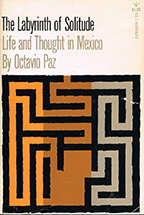Insightful analysis of a national psyche
In 1990, Octavio Paz became the first (and only, thus far) Mexican writer to win the Nobel Prize in Literature. His literary output includes over two dozen books of poetry. A volume of essays, however, is likely his best-known work among a worldwide readership. El laberinto de la soledad was first published in 1950. In 1961, it was published in English translation as The Labyrinth of Solitude. As indicated by the book’s subtitle, Life and Thought in Mexico, Paz analyzes the national character and spirit of his homeland, encapsulating not only the political but also the psychic state of the nation at the time of publication.
The original edition of The Labyrinth of Solitude is divided into nine chapters, each of which could be a free-standing essay on one or more aspects of Mexican culture. (Later editions, after 1970, may include an additional essay.) Because the book is now over 70 years old, some of its content may unavoidably be a bit outdated, but for the most part Paz’s observations still bear a timeless ring of truth. This is largely due to the fact that so much of Paz’s elucidation of the Mexican character revolves around the Mexican people’s coming to terms with their past—with their pre-Colombian history, the myths and religion of their heritage, the Spanish Conquest, Catholicism, the War for Independence, the Revolution, and the historical role of women in Mexican society. Born during the Revolution and writing less than four decades after that momentous upheaval, Paz illustrates how the mindset of the modern Mexican was forged from the country’s turbulent history. Paz’s attitude toward the Spanish Conquest, and Catholicism in particular, is not entirely negative and comes across as relatively lenient by today’s standards. We now regard European colonization as unilaterally evil and tragic, but Paz (and others of his era) seem more resigned to the brutal past as if it were an ugly contaminating ingredient that nevertheless proved essential in forging the strong and resilient alloy of an enduring racial and national spirit.
The scope of Paz’s text is not strictly confined to Mexico. Much of what he has to say about the Spanish Conquest and colonialism applies more broadly to Latin America in general. Also, in one of the latter chapters, Paz presents a very interesting and thoughtful perspective on twentieth-century world history, focusing primarily on the political and economic ramifications of numerous third-world revolutions and liberations from imperial colonizers. In the final chapter, Paz also addresses issues of gender roles, women’s rights, love, marriage, and sexuality with statements that shed light on Mexican attitudes but also speak of humanity as a whole. Paz is first and foremost a poet, not a historian, philosopher, or sociologist, so unlike writers in those disciplines he can get away with making bold metaphorical or opinionated statements without necessarily backing up his assertions with hard empirical evidence. Nevertheless, his arguments here are soundly reasoned and articulately stated (at least in the English translation by Lysander Kemp).
I read this book as an outsider with an interest in Mexican culture. I was hoping for insightful glimpses into Mexican life from one of that nation’s greatest intellectuals and men of letters, and in that regard, Paz did not disappoint. This book will no doubt be more meaningful, however, to readers of Mexican or Latino heritage. The Labyrinth of Solitude is a concise yet deep examination of the Mexican cultural and political zeitgeist as it existed almost three-quarters of a century ago. Much has changed in Mexico since then, but many of Paz’s conclusions are still very relevant today.
If you liked this review, please follow the link below to Amazon.com and give me a “helpful” vote. Thank you.



No comments:
Post a Comment